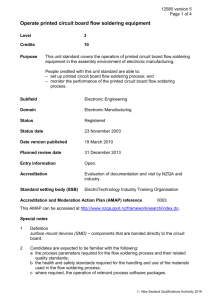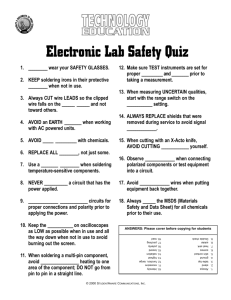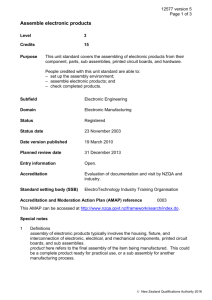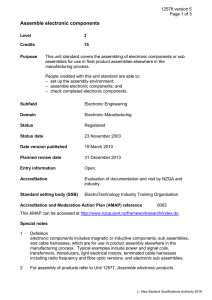Perform hand soldering in electronic manufacturing
advertisement
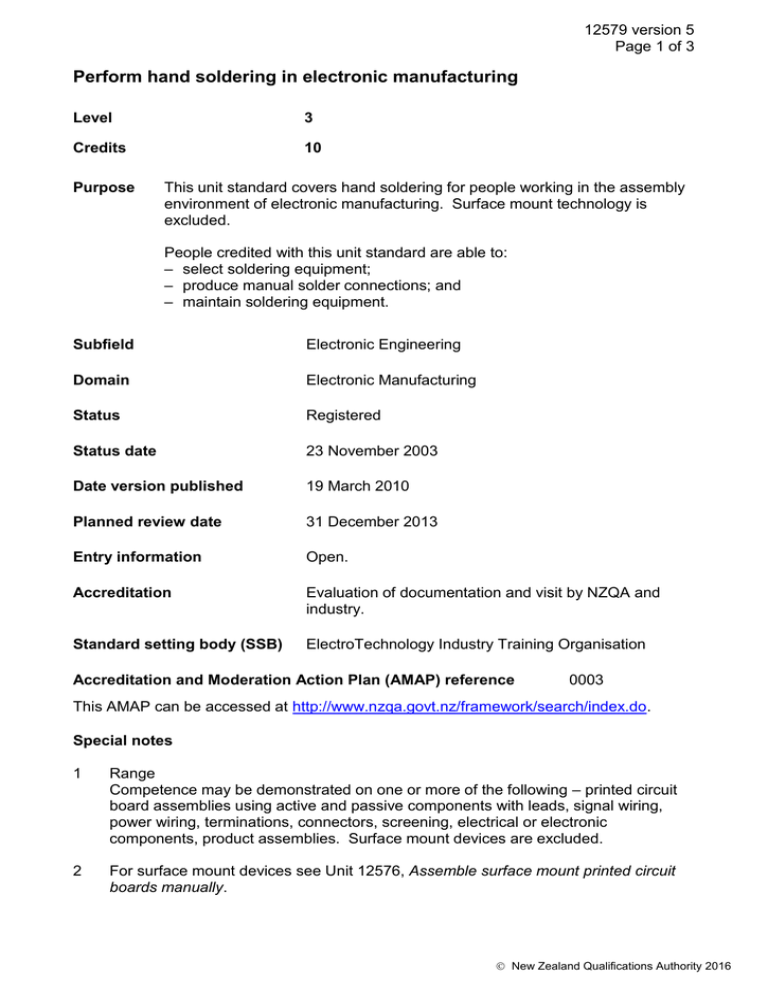
12579 version 5 Page 1 of 3 Perform hand soldering in electronic manufacturing Level 3 Credits 10 Purpose This unit standard covers hand soldering for people working in the assembly environment of electronic manufacturing. Surface mount technology is excluded. People credited with this unit standard are able to: – select soldering equipment; – produce manual solder connections; and – maintain soldering equipment. Subfield Electronic Engineering Domain Electronic Manufacturing Status Registered Status date 23 November 2003 Date version published 19 March 2010 Planned review date 31 December 2013 Entry information Open. Accreditation Evaluation of documentation and visit by NZQA and industry. Standard setting body (SSB) ElectroTechnology Industry Training Organisation Accreditation and Moderation Action Plan (AMAP) reference 0003 This AMAP can be accessed at http://www.nzqa.govt.nz/framework/search/index.do. Special notes 1 Range Competence may be demonstrated on one or more of the following – printed circuit board assemblies using active and passive components with leads, signal wiring, power wiring, terminations, connectors, screening, electrical or electronic components, product assemblies. Surface mount devices are excluded. 2 For surface mount devices see Unit 12576, Assemble surface mount printed circuit boards manually. New Zealand Qualifications Authority 2016 12579 version 5 Page 2 of 3 3 References Health and Safety in Employment Act 1992; ANSI/IPC J-STD- 001D, Requirements for Soldered Electrical and Electronic Assemblies, February 2005, published jointly by IPC – Association Connecting Electronics Industries and the Electronic Industries Alliance; IPC-A-610D, Acceptability of Electronic Assemblies, 2005, published by IPC – Association Connecting Electronics Industries. 4 The following apply to all elements of this unit standard: a all activities are to be completed and reported within agreed timeframes; b all work practices must meet worksite's documented quality management requirements; c all activities must comply with policies, procedures and requirements of the enterprises involved; and any relevant legislative and/or regulatory requirements, which include, but are not limited to, the Health and Safety in Employment Act 1992. Elements and performance criteria Element 1 Select soldering equipment. Performance criteria 1.1 The selected equipment and material are suitable for the soldering application. Range 1.2 performance may include but is not limited to – temperature requirement, tip size, tip shape, solder material, fluxes, cleaning material. The setup and operation of the soldering equipment meets enterprise quality and safety standards. Element 2 Produce manual solder connections. Performance criteria 2.1 Component performance is not affected by the soldering process. Range 2.2 physical, heat, electrostatic damage. The soldering process complies with required connection standards. Range standards include – cleanliness of joint, application of heat, solder materials. New Zealand Qualifications Authority 2016 12579 version 5 Page 3 of 3 2.3 The soldered connections comply with industry quality standards for the application. Range IPC standards, or equivalent, for physical appearance, mechanical strength, electrical properties, component placement. Element 3 Maintain soldering equipment. Performance criteria 3.1 Soldering equipment is turned off when not in use for long periods. 3.2 Corroded or damaged tips are repaired or replaced. 3.3 Sponge is kept clean and damp. 3.4 Coating of solder is left on the tip when soldering iron is not in use. Please note Providers must be accredited by NZQA, or an inter-institutional body with delegated authority for quality assurance, before they can report credits from assessment against unit standards or deliver courses of study leading to that assessment. Industry Training Organisations must be accredited by NZQA before they can register credits from assessment against unit standards. Accredited providers and Industry Training Organisations assessing against unit standards must engage with the moderation system that applies to those standards. Accreditation requirements and an outline of the moderation system that applies to this standard are outlined in the Accreditation and Moderation Action Plan (AMAP). The AMAP also includes useful information about special requirements for organisations wishing to develop education and training programmes, such as minimum qualifications for tutors and assessors, and special resource requirements. Comments on this unit standard Please contact the ElectroTechnology Industry Training Organisation reviewcomments@etito.co.nz if you wish to suggest changes to the content of this unit standard. New Zealand Qualifications Authority 2016
